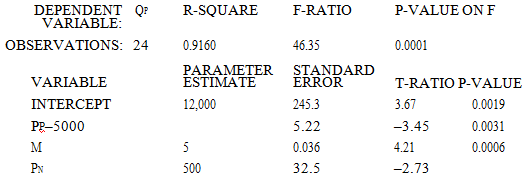Discuss the relationship between shoe brands| Microeconomics
Question 1
The Smith Corporation is a shoe-maker producing shoes branded P, while its competitor produces shoes branded N. It hires an economist to determine the demand for its shoes. After months of hard work and submission of an exorbitant bill, the economist tells the company that demand for the firm’s shoes is given by the following equation:
QP = a + bPP + cPN + dM
where QPis the number of shoes sold per month, PPis the price of shoes produced by Smith Corportation, PNis the price of shoes from competing maker, and M is consumer income. In the market served by Smith Corporation, income is currently $10,000. The following regression was tested for statistical significance at the 5% level of significance and the results were based on 24 monthly observations:

Discuss the relationship between shoe brands P and N, and also the type of good that shoes P can be classified as.
Discuss the meaning of R-square and the t-value for the parameter estimate on the Pp and PN.
If Smith Corporation sets the price of shoes (Pp) at $5 per pair and the price of its competitor’s shoes (PN) are sold at $6 per pair, analyse the impact on the sales of Smith’s shoes.
At the prices set in part c above, determine the price elasticity of demand for Smith’s shoes and explain what the magnitude of its elasticity at this point implies.
By computing the appropriate measure of elasticity, determine the probable impact if the competing shoe-maker raises its price.
In view of the fact that this is a time-series regression, discuss what possible variables could have been missed by the modeler, and explain briefly how easy it might be to include them.